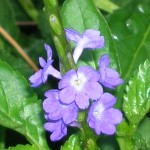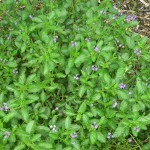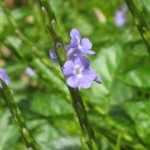Blue Porterweed (Stachytarpheta jamaicensis)
Names are so confusing sometimes. I mean, we seem to have trouble with directions. How did Cleveland, Ohio end up in the midwest? Probably not from continental drift. And we certainly can’t tell verbs from adjectives from nouns, so in football we play contain defense instead of containment defense, and in Congress we lock in the sequester instead of sequestration. Perhaps the explanation is simple: Our political leaders probably played football without helmets a few too many times.
Alas, even plant names have been afflicted with the language malaise. Take the blue porterweed, a beautiful small shrub native to Florida. Naturally, it is known as . . . Jamaican Porterweed, Stachytarpheta jamaicensis. And to make matters worse, over the years several exotic species have mistakenly been identified, photographed and sold as blue porterweed. True S. jamaicensis has a decumbent, i.e., sprawling, growth habit, and reaches a height of just a foot or so. The lowermost parts of the plant are lignified, or woody, and only the newer growth is flexible. There may be some mounding in blue porterweed, particularly in cultivated specimens.
The horizontally-spreading branches of this species bear dull leaves that are generally gray-green or light green in color, although a purple blush appears on some plants. The upper surface of the leaves is usually smooth, and the leaf margin is strongly serrated. Green flower spikes up to a foot long produce small blue flowers, starting at the bottom and working their way to the top each day. Each flower stays open for just a day, and there are usually 3-4 flowers open at the same time on each spike.
Among the other species of Stachytarpheta that have made their way into Florida are an upright, trunking representative from Asia and a large, pink-flowering shrub from South America. Neither is remotely like S. jamaicensis, but that hasn’t stopped confusion from reigning. Moreover, some hybrids have developed, and that has only deepened the morass. We’re afraid that misapplication of the name may persist long after the sequester stumbles over the fiscal cliff. However, we know for certain that Richard Lyons’ Nursery carries the true blue porterweed in 1-gal. containers.


